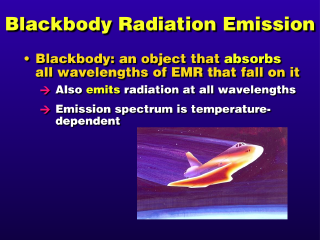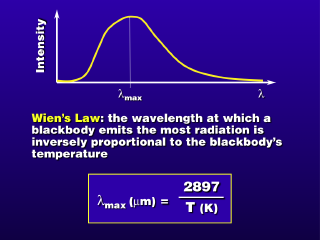 The hotter regions are along the leading edges, which appear white (actually, they're a blue, but so bright that they look white). The cooler region in the middle of the underside of the winds appear red. The colors correspond to the most intense wavelength emitted by the surface according to temperature.
The hotter regions are along the leading edges, which appear white (actually, they're a blue, but so bright that they look white). The cooler region in the middle of the underside of the winds appear red. The colors correspond to the most intense wavelength emitted by the surface according to temperature.
 In an inverse relationship, as the value of one side changes, the value of the inversely related parameter on the other side changes in the opposite sense. So, in Wien's Law, where blackbody temperature and the wavelength of maximum emission intensity are inversely proportional, increasing the temperature decreases the wavelength of maximum emission intensity.
In an inverse relationship, as the value of one side changes, the value of the inversely related parameter on the other side changes in the opposite sense. So, in Wien's Law, where blackbody temperature and the wavelength of maximum emission intensity are inversely proportional, increasing the temperature decreases the wavelength of maximum emission intensity.
"Lambda-max" is also known as the dominant wavelength of a blackbody, because the most radiation is being emitted at this wavelength, dominating the effects of the radiation emitted at other wavelengths. If lambda-max is in the visible wavelengths, then the blackbody will have a color (as perceived by a human's eye) based on the value of lambda-max. This value of lambda-max changes inversely with temperature, so blackbodies of relatively high temperature will appear to be blue (a short wavelength in the visible spectrum) and cool blackbodies tend to be more reddish (long wavelength in the visible).



 The hotter regions are along the leading edges, which appear white (actually, they're a blue, but so bright that they look white). The cooler region in the middle of the underside of the winds appear red. The colors correspond to the most intense wavelength emitted by the surface according to temperature.
The hotter regions are along the leading edges, which appear white (actually, they're a blue, but so bright that they look white). The cooler region in the middle of the underside of the winds appear red. The colors correspond to the most intense wavelength emitted by the surface according to temperature. In an inverse relationship, as the value of one side changes, the value of the inversely related parameter on the other side changes in the opposite sense. So, in Wien's Law, where blackbody temperature and the wavelength of maximum emission intensity are inversely proportional, increasing the temperature decreases the wavelength of maximum emission intensity.
In an inverse relationship, as the value of one side changes, the value of the inversely related parameter on the other side changes in the opposite sense. So, in Wien's Law, where blackbody temperature and the wavelength of maximum emission intensity are inversely proportional, increasing the temperature decreases the wavelength of maximum emission intensity.